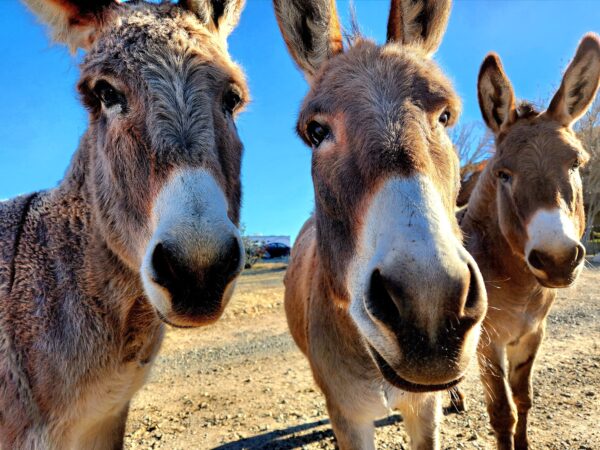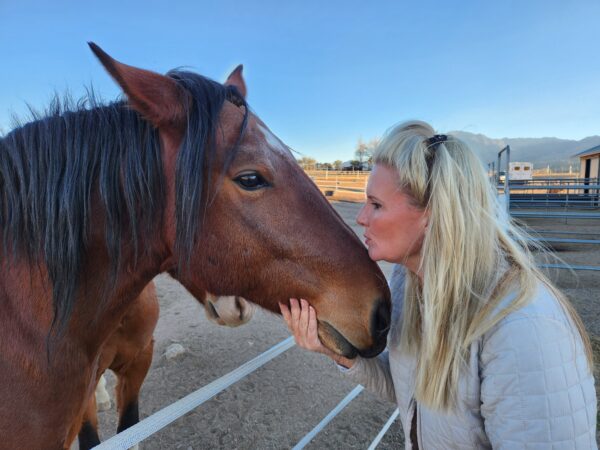PRESCOTT, Ariz.—Simone Netherlands grabbed a handful of inexperienced alfalfa hay and referred to as out to Apache, guarding a small band of Alpine wild horses on the reverse finish of the corral.
The younger stallion lowered its head warily and remained immobile at seeing a customer standing beside her.
“C’mon,” Netherlands stated to the horse gently, waving the hay and coaxing the animal to come back over.
Slowly, Apache stepped ahead to the sting of the metallic fence, poked its nostril via, and started munching on the moist straw till it was all gone.

To her customer, she stated, “He has a stunning mane. They’re so cute. You wish to pet them.”
However it was nonetheless a lot too quickly for Apache.
When Apache first arrived on the wild horse sanctuary weeks in the past, he was depressed—grieving, Netherlands stated.
A number of in his band had been shot and killed in early October in an organized act of cruelty deep contained in the Apache-Sitgreaves Nationwide Forests in japanese Arizona.
Heartless Acts
Two months after the killings, Netherlands, president of the Salt River Wild Horse Administration Group, nonetheless can’t fathom the motive behind them and the sheer heartlessness of all of it.
The horse dying toll is now at 41. Some had gunshot wounds within the stomach, lungs, and face, and have been left to die the place they fell.
By some means, a number of managed to outlive their wounds.

There are nonetheless no suspects, and “no person takes duty for it,” Netherlands stated. “There’s simply loads of unjustified hate over wild horses. It’s arduous to know.”
The U.S. Forest Service buried a number of useless horses in mass graves, their areas revealed solely by the newly turned soil.
Netherlands stated it’s solely a matter of time earlier than volunteer discipline watchers uncover much more carnage throughout the 2.7-million-acre forest.
“We consider there have been over 50 killed,” Netherlands stated. “Now we have 11 nonetheless lacking.”
Volunteers with the Salt River group and Alpine Wild Horse Advocates have been protecting monitor of the horses utilizing a software program utility with their cell telephones.
Every horse has been given a reputation, logged, and photographed.
“So, we let the general public identify them as a result of they like to be concerned. That personalizes them—’Oh, they caught Apache.’ However to see them butchered—shot within the woods”—Netherlands stated that was the work of “monsters.”
And it has shaken her religion in humanity.

In Apache’s band, Kiowa and Amari are the few final ones standing. These shot and killed will reside in photos on the wild horse advocacy teams’ Fb pages.
The Forest Service plans to spherical up the remaining Alpine herd—some 200 horses—and promote them at on-line auctions as “unauthorized livestock” till they’re all bought.
Even after the October killings ceased, the Forest Service didn’t cease rounding up the horses, Netherlands informed The Epoch Instances.

“Virtually every single day, we proceed to search out extra [carcasses], and we nonetheless suppose they’re all from the identical occasion.”
In mild of the unexplained shootings and systematic roundups, wild horse advocates really feel they’re in a race as they scramble to purchase as many horses earlier than the “kill patrons” do. The kill patrons will transport and promote the horses to the slaughterhouses in Mexico.
Shopping for Time
The Salt River group bought 105 of the unique 400 wild horses within the Apache-Sitgreaves herd due to public donations. The overall price was round $11,000.
Netherlands stated the volunteers would solely cease shopping for them as soon as they may save as many horses as doable and place them in everlasting properties.
“It’s some huge cash,” she stated. “The unhappy factor is that there’s not loads of curiosity or good properties for them. It’s arduous for the general public to deal with wild horses. You’ve obtained to know the strategy; typically, it fails.”

The Forest Service will maintain one other on-line public sale on Dec. 10.
It’s an sad dilemma, Netherlands stated. If the wild horse advocates can’t discover good properties for the horses, “we will’t rescue them.”
Within the worst case situation, many horses might find yourself in meat processing factories south of the border to be bought internationally.
“It’s very determined. It’s simply a lot stress on the people who love them,” Netherlands stated.
Thankfully for Apache and 11 different current wild horse rescues, the Salt River sanctuary might be their house—maybe for the remainder of their lives.
Netherlands described the connection between wild horse advocates, the Forest Service, cattle ranchers, and sure environmental teams as sophisticated—an unhealthy collision of opposing pursuits.
The Forest Service views the horses as invasive livestock, topic to elimination. Wild horse advocates think about them a historic breed relationship again to the early Spanish explorers of North America.
Netherlands stated that an Arizona state historian is assured these are genuine wild horses worthy of federal and state safety. Nevertheless, the Forest Service stated there is no such thing as a proof the horses are something however “feral” livestock encroaching on authorities land.

“They’re thought-about unauthorized livestock and subsequently fall underneath livestock rules over which the state has jurisdiction,” the Forest Service informed The Epoch Instances in an e mail.
The Salt River group regards humane chemical contraception of the herd probably the most affordable resolution, however the Forest Service isn’t , Netherlands stated.
“They most likely didn’t consider us, however they gave us time to show it. This 12 months we solely had one foal in the complete 12 months. That in comparison with 100 foals in 2019. So everybody can see now that it’s working.”
Nonetheless, the Forest Service stated it has no authorized authority to implement a contraception program for the reason that horses don’t come underneath federal jurisdiction.

One other various resolution can be to craft laws to guard the horses. Wild horse advocates are working to perform this on the state degree, although it could come too late to avoid wasting the remaining horses.
As for the current killings, Arizona has solely confirmed that 30 horses died within the October incident. As a result of the Forest Service doesn’t have jurisdiction, “and due to the continuing nature of the investigation, we can’t supply additional info,” the company stated.
Investigation Below Approach
The Arizona Division Of Agriculture is accountable for the investigation. Netherlands stated the proof consists of DNA samples and bullets taken from the useless horses, together with a knife with fingerprints discovered on the scene.
The Forest Service stated its coverage to take away the horses is a “mandatory step” to make sure that the forest is “wholesome and sustainable for years to come back.”
As feral horses, they don’t obtain safety underneath the 1971 Wild Horse and Burro Act.

“These feral horses trigger substantial issues for not solely native crops and animals … however additionally they destroy watersheds and negatively affect ecosystems,” the Forest Service stated on its web site.
The Salt River group disagrees with the federal government’s label and lately commissioned horse geneticist Gus Cothran to look at tissue samples from the carcasses to find out if they’re, the truth is, Alpine wild horses.
A positive willpower might change every little thing—legally.
Because the Forest Service considers the horses a risk to endangered species just like the New Mexico meadow leaping mouse, the answer is to spherical up the horses and promote them at public sale.

“It really is an outrage. We’re shopping for [the horses] as a result of we now have no different selection,” Netherlands stated. “However sadly, solely about 100 are left in areas nonetheless accessible the place folks can see them.”
The very best current bid value for a horse bought at public sale was $975. Others have bought for as little as $50, Netherlands stated.
The Salt River group hopes to buy bands of horses to maintain the household bonds intact.
“There are solely two choices. Both we purchase them, or the kill-buyer buys them. We solely wish to bid in opposition to the unhealthy purchaser.”
To complicate issues, the Forest Service lately introduced a collection of managed burns involving hundreds of acres of the Apache-Sitgreaves forest the place many Alpine wild horses reside.

“It’s simply one other assault on the wild horses and their habitat. If fences are in the best way, they get caught and burn,” Netherlands stated.
“They’re making an attempt to persuade us that the wild horses eat all the expansion, they’re unhealthy for wildlife, they’ll’t reside along with cows—that’s the propaganda inflicting all of the anger.
“So now, they’re burning this forest. Do you suppose the [endangered] mice received’t burn?”
The Forest Service stated its administration program of using managed burns took years to plan and assess altering situations, “together with any unauthorized livestock gathering operations.”

“If the situations on the bottom are applicable, together with many different elements together with potential air high quality and accessible sources, then prescribed fireplace tasks transfer ahead.”
If any a part of the method falls “past allowable limits,” the Forest Service stated it is going to reschedule the venture till a “extra applicable window of alternative arises.”
Wild horse advocates like Netherlands say they would like the horses to co-exist with ranch cattle and wildlife and that there’s loads of house and grassland.
“It’s about studying to share our public lands. Everybody will get a bit of it,” Netherlands stated. “There’s a win-win resolution on this for everybody.

“The herd is declining in inhabitants numbers. The general public nonetheless will get to see them. They purchase a day cross; the Forest Service will get the income. So they’re an vital leisure useful resource.”
Sanctuary From the Hunt
At the very least for now, the Salt River sanctuary is the following finest habitat for rescued wild horse Apache, with a non-public stall, acres of fenced grassland, and loads of meals to eat.
When Apache arrived on the sanctuary, the trauma of shedding members of his band was evident in his sullen conduct. The sight of people was an extra trigger for anxiousness.
Netherlands stated it took her weeks to realize a measure of Apache’s belief.

Even now, the chocolate brown stallion is skittish and aloof with strangers, like many different new arrivals. They embody yearlings, grownup mares, and stallions.
“So, to start with, we needed to feed [the yearlings] milk pellets. As a result of horses that younger can’t reside solely on grass,” Netherlands stated.
“What’s up, gals?” she stated to a pair of Alpine mares coming to eat hay out of her hand.
Netherlands stated she tries to remain optimistic via all of it, hoping those that oppose the wild horses in the future will see the nationwide forest for the historic timber.

“It could be an absolute atrocity if we removed this animal that has at all times been part of Arizona. It’s the animal that introduced us right here—the animal on whose again we constructed this nation,” Netherlands stated.
“Now we have such little respect for them. We paint photos of them. Now we have statues of them. However in the case of the actual horse, no person cares.”





